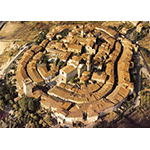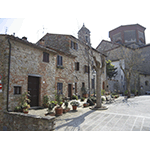Palazzo Comunale of Lucignano
Probably of 13th century origin but substantially rebuilt in the 14th, the Palazzo Comunale of Lucignano (the former Palazzo Pretorio) bears on one side of the building an antique mechanical clock dating from 1730, placed there by the Roman craftsman Antonio Giacchei as replacement for an earlier one. The dial has six Roman numerals in copper, originally gilded, applied directly to the façade. The frame, in wrought iron of the "a castello" type, was repaired for the last time in 1954. On the ground floor of the Palazzo is the Lucignano Municipal Museum, which displays, among its many art objects, the two weights from the ancient clockworks.
The Palazzo is inserted in a remarkable urban context. With its characteristic elliptical shape with concentric ring streets, the fortified village of Lucignano constitutes one of the most interesting examples of a medieval town surviving to our own day. Located in a zone of strategic importance, it was long contested by the cities of Arezzo, Siena, Florence and Perugia for domination over the Valdichiana. Surrounded with walls by the Sienese already in 1371, the town was further fortified by the Florentines with the construction, around 1558, of a fortress at the order of Cosimo I de' Medici, attributed to the architect Bernardo Puccini. In addition to the Fortress and the Rocca, extensive sections of wall are still visible in the town, with a broad escarpment, three of the original doors and two towers with projecting defensive structures (a gallery in masonry).
****************************
Texts by Elena Fani
English translation by Catherine Frost
Last update 10/gen/2008





